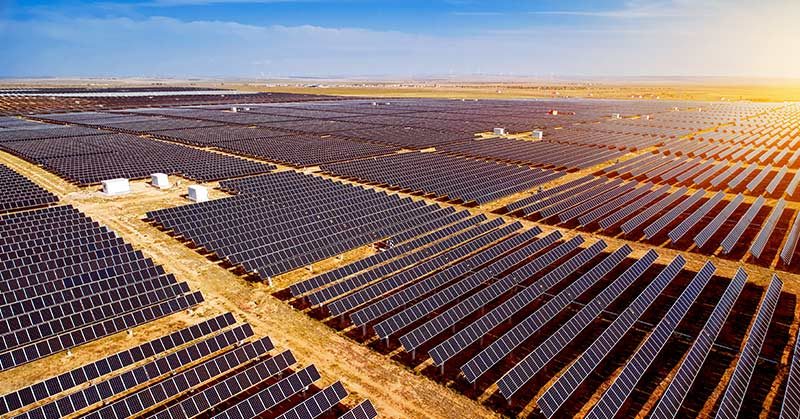When it comes to making the transition to renewable energy, there is one concern on everyone’s minds: the cost. If renewables are more expensive than oil or gas, using them for large-scale power generation is not feasible. A recent report, however, has found that solar power cost is lower than every other form of energy generation.
Solar Power Cost Dropping
The International Energy Agency (IEA) recently released its World Energy Outlook 2020. The report made a number of important observations and predictions, but among them, one stood out: by 2040, we will see a major rise in renewables.
Specifically, the IEA predicts 43 percent more solar output by 2040 than it originally predicted in 2018. Why? Because solar power is twenty to fifty percent cheaper than they thought [1].
According to the report, solar power currently offers some of the cheapest power ever seen. In areas that have the best policy support and finance, the report found that solar power can generate electricity at or below US twenty dollars per megawatt hour. This is significantly less than coal or gas. Experts expect this cost to continue to fall.
In particular, the IEA expects solar costs in India to drop 65 percent over the next two decades.
“Within half the lifespan of a new coal-fired power plant, solar will be essentially free in one of the largest electricity markets in the world,” said Tim Buckley, from the Institute for Energy Economics and Financial Analysis. “It’s all about the economics, it’s all about the capital flows, and global capital is flowing into renewables and running for the door on fossil fuels.” [2]
Solar Power Cost and Climate Change
Scientists are saying that the next ten years will be crucial in reversing the current trajectory of climate change. Countries need to convert to clean and renewable energy if we want to reduce emissions from fossil fuels [3].
Despite this, the IEA expects global carbon emission to increase in 2021. In their report, they pushed for clean energy investment to create economic growth and jobs while reducing emissions. Only the UK, Canada, New Zealand, South Korea, and the EU, however, have actually done this.
Dr. Fatih Birol, the IEA Executive Director, says that only faster structural changes to the way we produce and consume energy can lead to a permanent decline in global CO2 emissions.
“Governments have the capacity and the responsibility to take decisive actions to accelerate clean energy transitions and put the world on a path to reaching our climate goals, including net-zero emissions,” she says [3].
COVID-19: An Environmental Opportunity
Experts are predicting that the COVID-19 crisis will cause a dramatic decline in global energy demand in 2020. Fossil fuels, they say, will see the largest decline. The researchers outlined four possible scenarios for the future as the pandemic progresses.
One of these scenarios includes the possibility of the world getting COVID-19 under control by 2021, and the demand for energy bouncing back. Eighty percent of this growth will come from renewables to 2030. That possible future, however, assumes that governments don’t push for more sustainable energy than they did before the pandemic.
“I see solar becoming the new king of the world’s electricity markets,” Dr Birol said [2].
The IEA says that there has been a “structural shift” away from coal after the coronavirus. The researchers predict that coal will rise marginally over the next few years, but begin to decline after 2025. This fall, however, will not be enough to meet the Paric target, which is well-below two degrees [1].
Reaching Net-Zero Emissions
The report outlined that in order to reach the ultimate of net-zero carbon emissions, it will require contributions from the power sector, energy end-use, as well as individual behaviour changes.
Of course, the power sector will contribute the largest portion of the savings, but the report gave a detailed analysis on how individual behaviour change is crucial to achieving net-zero emissions.
Simple actions like cutting down on flights and turning down air conditioning, will contribute significantly to reaching that goal.
Still, the report estimates that sixty percent of these changes will be influenced by governments, who implement legislation such as controlling car use in cities. In fact, people’s transport choices will be the largest contributor to emissions savings by individuals [1].
As more companies shift to work-from-home policies, this could cause a massive decrease in global CO2 emissions. The report estimated that if even just twenty percent of workers around the globe could work from home one day per week, we could save eighteen million tonnes of CO2 in 2030 [1].
Low Solar Power Costs for a Bright Future
While there is still much work to be done in order to reach the decreased levels of emissions required to prevent climate change, the decreasing cost of solar power bodes well for sustainable energy production.
The shift to more renewables, however, depends on governmental support from every nation.
“The era of global oil demand growth will come to an end in the next decade,” Dr Birol said. “But without a large shift in government policies, there is no sign of a rapid decline. Based on today’s policy settings, a global economic rebound would soon push oil demand back to pre-crisis levels.” [3]
As solar power surpasses oil and coal in terms of cost efficiency, more governments will begin pushing for renewable energy. Hopefully, that will mean that over the next decade solar power, along with other renewables, will become our go-to source to power our homes, communities, and countries.
Keep Reading: World’s Largest Solar Farm to Be Built in Australia – But They Won’t Get The Power
- https://www.carbonbrief.org/solar-is-now-cheapest-electricity-in-history-confirms-iea
- https://www.abc.net.au/triplej/programs/hack/solar-is-now-the-cheapest-electricity-in-history-report-says/12767310
- https://www.independent.co.uk/environment/solar-power-energy-carbon-emissions-global-warming-climate-change-crisis-b1016301.html

